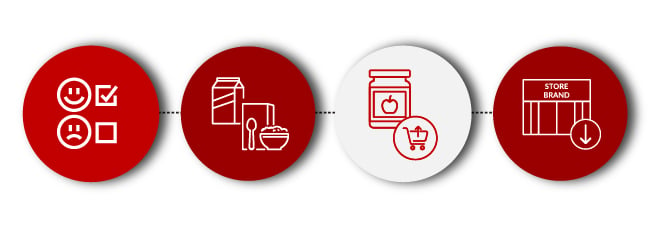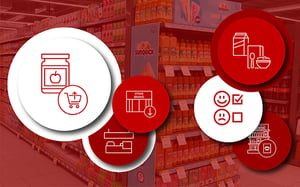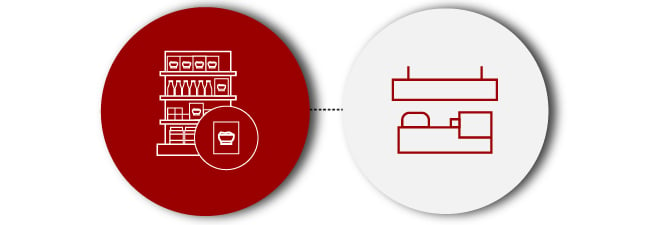Any end cap positioned in your store serves a purpose. No matter if you set up these displays to sell more product or bring attention to a new promotion, they are valuable. That’s why, when setting up your end caps, you shouldn’t position them randomly. Instead, you need to be strategic. How? One way is to ensure your end caps match their category adjacencies.
What are category adjacencies?
Before we consider the reasons why any end cap in your store should match its category adjacencies, it’s worth defining ‘category adjacency’. What is it exactly?
Fortunately, it’s straight-forward.
What’s more, as soon as you understand what a category adjacency is, the reasons for why they should match your end caps becomes apparent.
Here is that explanation:
A category adjacency refers to the categories placed next to or opposite each other within a gondola run or aisle. Usually placed next to each other according to how your shopper uses them, these categories are meant to complement each other. We’ll explain what happens if they don’t match later on in this piece.
For example, if you have a promotion on a new shaving foam product, you could place it in an end cap at the top of an aisle that stocks your shaving items. Alternatively, you could switch it up and bundle products in your end cap that you find within the aisle.
The choice for how you approach your end caps is up to you. So long as your match the products placed on your end caps with their category adjacencies, you shouldn’t have a problem.
Of course, it’s not about the problems that you can run into if you don’t match them. Instead, this is about the opportunities that you can lose out on if you’re not strategic when setting up your end cap displays in-store.

Why must an end cap and its category adjacencies match?
1. It allows you to provide a pleasant shopping experience for your customers
In today’s fast-paced world, your customers don’t have the time to walk around in your store for long periods looking for products. They also don’t want to do that. Place yourself in their shoes, and you’d likely feel the same way. You’d want to find products easily so you can get in and out without a fuss.
That’s where your end caps and category adjacencies come in. By matching them correctly, you can create a store that is pleasant to shop. Do it often enough, and you might find shoppers spending more time (and money) in-store.
Let’s say, for example; you have a special on biscuits. In that case, you could use your end cap as a bulk display to show off that biscuit. The aisle contains all the other cookies and rusks. Adjacent to that, you could place a small selection of baking goods, other sweets, as well as coffees and teas.
The result is you have a shopper drawn to the end cap display to add the biscuits to their baskets. While they’re there, they realise they’re low on coffee. Because the item is within arm’s length, they can place it in their basket.
That leads to a related point. As much as your end caps act as an opportunity to market a new product or promote an existing one, you can also use them as a guide to your store layout.
How so?
When a customer first walks into your store, they’re likely to look at the end caps to see where they need to go. That’s besides looking at any signage above each aisle. As soon as they spot the biscuit display, for example, they’ll recognise the category and know what to expect from the aisle.
Your customers have most likely mentality checked off the items they’d expect to find if they walk down that aisle. It’s then up to you to meet their expectations.
And if you don’t? You’d end up with confused and frustrated shoppers.
2. It offers you cross-merchandising opportunities
The fact that matching your end caps and category adjacencies leads to a better shopping experience is one thing. You can group products in a way that makes sense to anyone who walks through your store.
As a retailer, you can also use this to your advantage. How? Quite simple: you can use it as a cross-merchandising opportunity.
Let’s say, for example; you stock a barbecue category. Within this category, you’d merchandise your firestarters and barbecue grills and tools and so on. For your end cap, you could have a barbecue starter kit. Moreover, within the display, you could include sauces or even various meat products.
Then, to supplement that, within the aisle, you can put in clip strips holding these sauces for additional sales. Alternatively, you could put up temporary or permanent stands and signage, offering them products indirectly connected to the barbecue category.
What is so significant about this is that shoppers won’t see this as anything other than convenient. That’s where it ties in with the above point about creating a pleasant and smooth shopping experience. You can offer shoppers multiple products in one area, so they don’t have to go looking for them.
Of course, you can go wrong. That happens when you overthink what you’re doing and attempt to do too much.
For example, you might want to add baby diapers in the liquor aisle because your POS data might indicate that people who buy liquor often have diapers in their baskets. However, is that logical? It may merely be a coincidence.
Likewise, a customer is not going to buy liquor along with baby diapers because you have put them near each other. They might not get angry at seeing unrelated items next to each other. However, there is every possibility that they’ll be frustrated if you don’t merchandise similar products in close proximity to each other.
3. It can help you to grow your categories in-store
The direct result of providing a pleasant shopping experience and cross-merchandising similar products is category growth.
That’s why it’s our next point. By matching your end caps and category adjacencies, what you can achieve, more than anything else, is an increase in basket size and with that, more sales and profits. It helps if you pair items that sell at a good margin.
Let’s say, for example; a customer walks into your store looking for a printer. They come in wanting to get the cheapest black and white single function printer. When they arrive at the aisle where you stock printers, on your end cap you’ve placed a laptop special that includes a printer.
As they see the special, they remember that their brother or sister needs a new laptop for school. Considering they’re getting the printer, and at a discount, what’s the harm in spending more? So they take the offer. But, now they need other items, such as a laptop bag, a mouse, some software. Before they know it, they could have spent double or triple what they intended.
The fact that you’ve presented products that shoppers would use together means there is also less resistance to placing these products in their baskets.
Another example is your fruits section. On your end cap at the end of the aisle, and besides the strawberries, you could include cream. What goes together better with strawberries than cream?
It’s also worth pointing out that having a product on your end cap display creates the perception of value for that product or brand, thereby increasing the possibility of more sales and growing your category.
What’s more, it’s not only about growing one category (Diary) but multiple (Diary and Fruit) if you decide to cross-merchandise too.
4. Stocking unrelated products next to each other can damage your store’s reputation
While the above three reasons for matching your end caps and category adjacencies are all because of the opportunities it can create for your stores; there is one reason why you can’t get it wrong.
As you’ll have read in the sub-heading, by not matching the two, there is every possibility of your store ruining its reputation. If that appears melodramatic, it’s not.
Here’s an example to illustrate what we mean:
A customer walks into your store, looking for baby diapers. They see an end cap with products that indicate it could be the aisle where they’d find such items. However, upon reaching the aisle, they find pool cleaning equipment or dog toys, for example. You instantly confuse the shopper, who now has to go to a different aisle to see what they want.
Here’s another example: On an end cap, you place towels, and so a shopper may expect to find more bathroom accessories. However, in the aisle, they might find camping equipment and air mattresses.
Where do they even start if the end cap doesn’t reflect what’s in the aisle?
Beyond that fact, you also waste your space. Considering the space in your store is one of your most significant assets, you’d want to manage it correctly. That won’t happen if you begin putting merchandise anywhere in your store. You can guarantee that you’ll lose sales because shoppers won’t walk your entire store looking for items that should not be in the right location.
They’ll walk out and consider your store as disorganised and unshoppable. They could even mention that to their friends and family who will mention it to others.
Conclusion
DotActiv’s planogram software is used by over 1500 retail professionals in more than 60 countries across the globe. Interested in finding out more about how we can enable you to use your business data to create better product layouts, localised assortments, advanced retail analytics and more?
You can visit our online store here.



